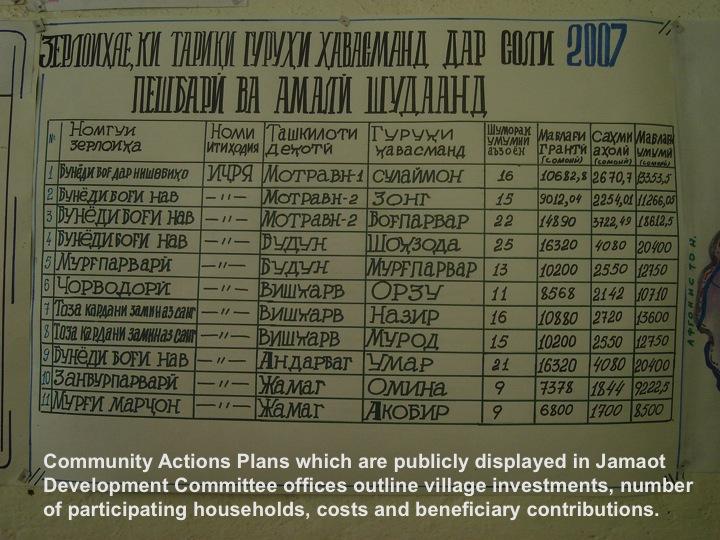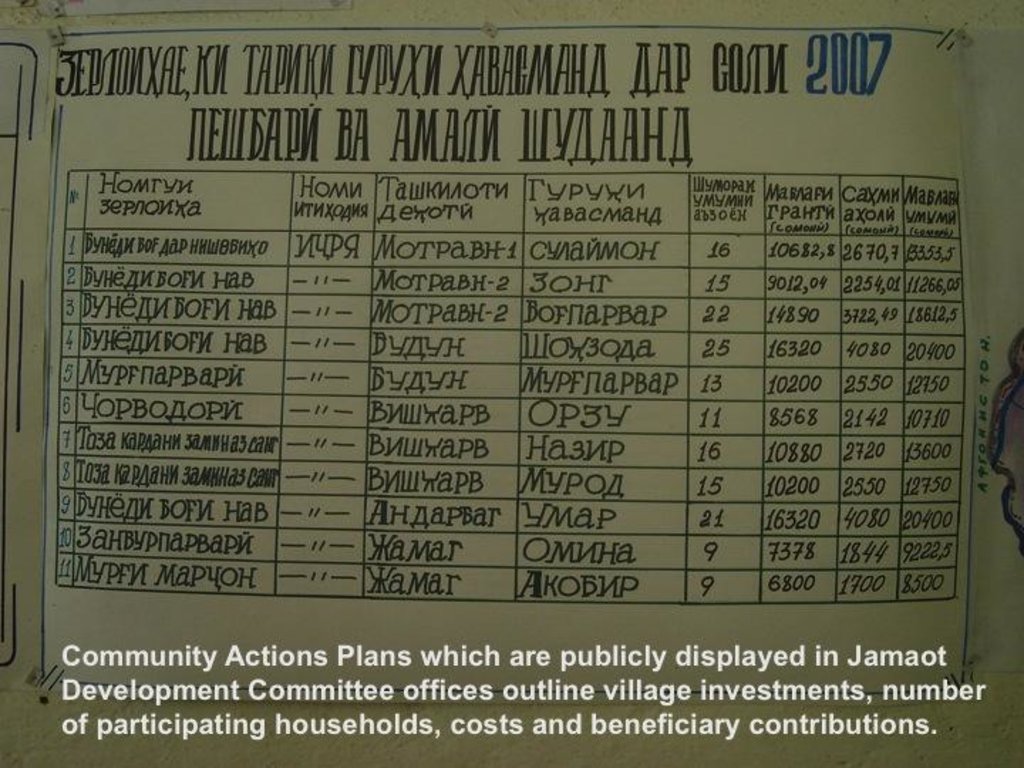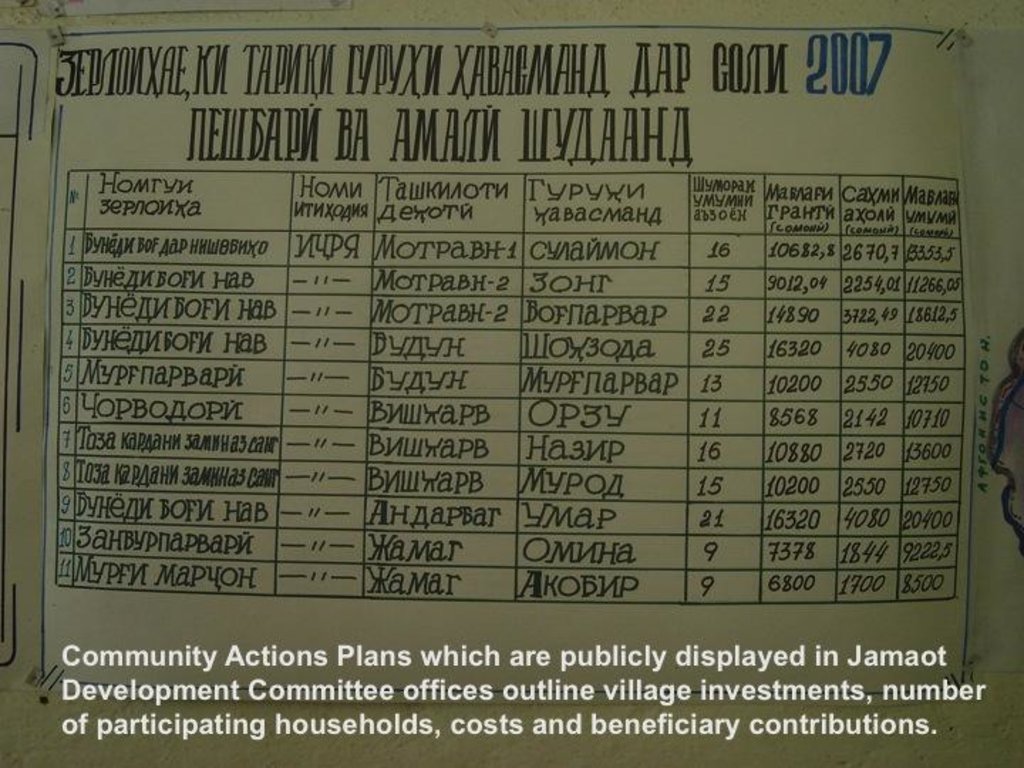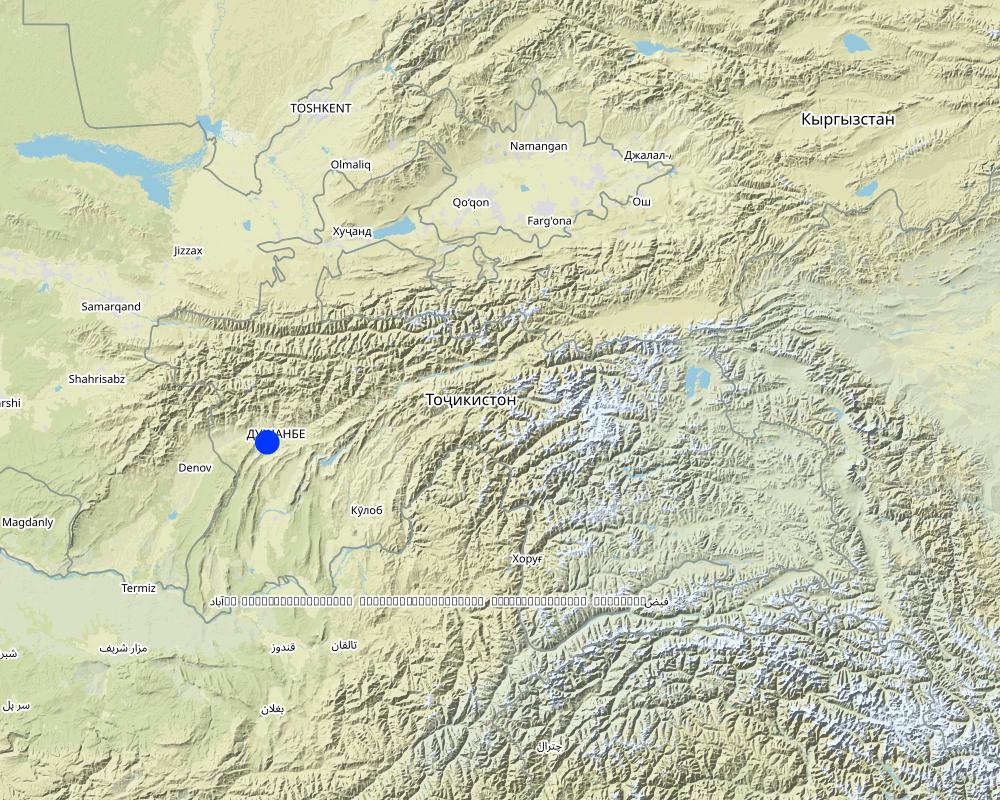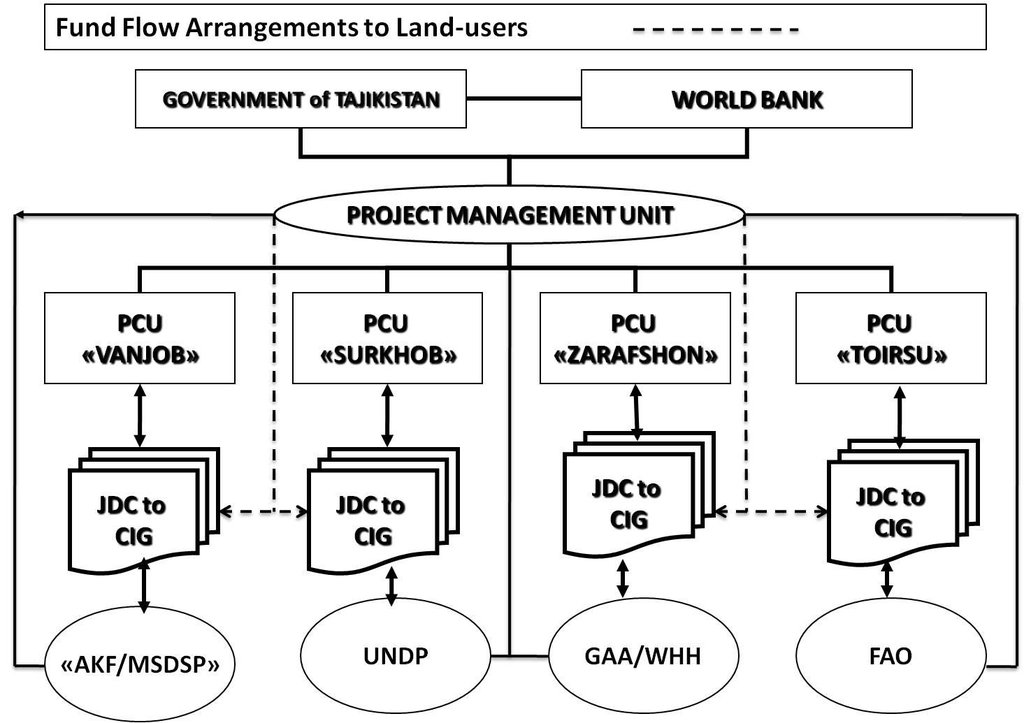SLM small grant allocation mechanisms [Tajiquistão]
- Criação:
- Atualização:
- Compilador/a: Nandita Jain
- Editor: –
- Revisores: David Streiff, Alexandra Gavilano, Joana Eichenberger
approaches_2453 - Tajiquistão
Veja as seções
Expandir tudo Recolher tudo1. Informação geral
1.2 Detalhes do contato das pessoas capacitadas e instituições envolvidas na avaliação e documentação da abordagem
Especialista em GST:
Mott Jessica
World Bank
Nome do projeto que facilitou a documentação/avaliação da Abordagem (se relevante)
Pilot Program for Climate Resilience, Tajikistan (WB / PPCR)Nome da(s) instituição(ões) que facilitou(ram) a documentação/avaliação da Abordagem (se relevante)
World Bank (World Bank) - Estados Unidos1.3 Condições em relação ao uso da informação documentada através de WOCAT
O compilador e a(s) pessoa(s) capacitada(s) aceitam as condições relativas ao uso de dados documentados através do WOCAT:
Sim
2. Descrição da abordagem de GST
2.1 Descrição curta da abordagem
Mechanisms to facilitate participatory decision-making about grant allocation among land users and improve transparency and accountability in flow of funds to beneficiaries in small-grant programmes for SLM.
2.2 Descrição detalhada da abordagem
Descrição detalhada da abordagem:
Aims / objectives: As part of the Community Agriculture & Watershed Management Project (CAWMP), this approach helped beneficiaries and project partners allocate grants and manage the flow of funding while promoting fairness, transparency, and ownership. It facilitated appropriate SLM choices across the highly variable agricultural, climatic and geographic conditions. Almost 4000 rural investments including SLM technologies were implemented, resulting in over 96,000ha under improved land management practices and benefits for more than 43,000 households in Tajikistan’s uplands.
Methods: This approach set a fixed budget per village, limited the grant value received per household as well as the total size of any one grant, required minimum levels of beneficiary contributions, and provided grant money to beneficiaries, enabling them to purchase the inputs.
Stages of implementation: Fixed village budget: In their Community Action Plans (CAP) villages assigned priorities to grants within a set budget amount for the entire village. Project guidelines specified a formula for this budget based on amounts per investment type per household excluding beneficiary contributions ($30/household for farm productivity, $74/household for land management, and $30/household for rural infrastructure). The number of households in a village multiplied by these per-household-amounts determined the overall size of the grant funding for that village. Grant allocation limits. The villages were informed of their overall budget as well as the household limits for each category. They chose investments for groups of households (Common Interest Groups, CIGs) and allocated grant funds to subprojects accordingly. The household limits ensured that collectively at least 50% of the families would benefit directly. In practice, about 75%, of a total of about 57000 households in the project sites participated in the farm productivity and land resource management investments, and 60% in rural infrastructure investments. Grant size. Except in a few cases requiring special approval, the Project-financed grants for each subproject were lower than US$5,000, which reduced risks of the funds being used for purposes for unrelated to the Project. Beneficiary Contribution. Beneficiaries were required to contribute a minimum of 25% of the grant amount in labor, materials or cash which increased their stake in the investment, thereby strengthening ownership and sustainability. At least 5% of the grant amount for rural infrastructure had to be contributed in cash at the start in order to demonstrate financial sustainability.
Role of stakeholders: Fund flow. Once a grant proposal was approved, the PMU transferred the grant amount to the local savings bank according to the schedule specified in the agreement between Jamoat Development Committee (JDC) and CIGs. The JDC accountant transferred the funds fromthe bank to the CIGs. The CIGs then had the responsibility for purchasing inputs, which created an incentive for selecting cost-effective inputs.
2.3 Fotos da abordagem
2.5 País/região/locais onde a abordagem foi aplicada
País:
Tajiquistão
Região/Estado/Província:
Sughd, Region of Republican Subordination, Khatlon, GBAO
Especificação adicional de localização:
Jirgital, Tajikibad, Vanj, Aini, Matcha, Penjikent, Danghara
Comentários:
The Community Agriculture and Watershed Management Project was implemented in four project sites/watersheds - Surkhob, Toirsu, Vanjob and Zarafshan - which included 7 districts/raions and 39 sub-districts/jamoats. The total catchment area was 35,000km2. Total arable, farm and pasture land was approximately 319,500ha.
Map
×2.6 Datas de início e término da abordagem
Indique o ano de início:
2005
Ano de término (caso a abordagem não seja mais aplicada):
2012
2.7 Tipo de abordagem
- Baseado em projeto/programa
2.8 Principais metas/objetivos da abordagem
The Approach focused mainly on other activities than SLM (small grant programmes, participatory decision-making, village-level, fixed budgets, fund flow arrangements, farmer groups)
Practical and feasible mechanisms for beneficiaries and project partners for: a) grant allocation and fund flow that promote fairness, transparency, and beneficiary ownership in the context of Tajikistan; and b) facilitate appropriate SLM choices across the highly variable agro-climatic and other geographic conditions of the country.
The SLM Approach addressed the following problems: Prior to CAWMP, no practical incentives in donor-funded grant programmes for beneficiaries to consider how to optimise returns according to local conditions. Limited choice of technologies, elite capture of resources, requests for large grants and absence of beneficiary contributions led to inappropriate investments for local agro-climatic conditions, and poor returns and investments not maintained in subsequent years.
2.9 Condição que propiciam ou inibem a implementação de tecnologia/tecnologias aplicada(s) segundo a abordagem
Normas e valores sociais/culturais/religiosos
- Inibitivo
Grant allocations vulnerable to elite capture and/or political influence. Time taken to address such pressures.
Treatment through the SLM Approach: Participatory planning and full disclosure at the start of planning to villagers of available funding and its calculation at village and household levels.
Disponibilidade/acesso a recursos e serviços financeiros
- Inibitivo
Beneficiary dependence on donors/implementing agencies since resources given were “in-kind” and not cash.
Treatment through the SLM Approach: Adopted “good practice” from other countries with arrangements for direct cash transfers to beneficiaries organised as groups of farmers who then had responsibility for managing financial resources and procurement for chosen investments.
Quadro institucional
- Inibitivo
Lack of active participation by beneficiaries in decision-making over grant amounts and choice of investments.
Treatment through the SLM Approach: Innovative rules about grant allocations enabling villagers to consider various options of grant amounts and types of investments in a participatory manner, taking into account their local conditions.
Conhecimento sobre GST, acesso a suporte técnico
- Inibitivo
Participatory planning processes lacked consideration of multiple factors, e.g., grant amount, choice of technologies, local context, beneficiary contribution, selection of beneficiaries.
Treatment through the SLM Approach: Inclusion of participatory rural appraisal, formulae and rules governing grant allocations in CAP preparation. First 3 proposals for each investment category in project sites reviewed to assess understanding of guidelines. Random review thereafter.
3. Participação e papel das partes interessadas envolvidas
3.1 Partes interessadas envolvidas na abordagem e seus papéis
- Usuários de terra/comunidades locais
CIGs (Groups of households)
Local cultural and social conditions determined the extent to which women took part in the grant allocation decision-making, and as members of CIGs managing small grant funds. In some more remote communities, it was not generally acceptable for women to be active participants. In other areas, women only CIGs were formed.
Marginal groups within a generally poor upland rural population participated in grant allocation decisions and as CIG members in managing small grant funds. In some villages, vulnerable and poor households were targeted as priority recipients of grants through the allocation mechanism.
Participated grant allocation decision making and fund management
- Organização não governamental
JDCs – locally registered NGOs
JDCs managed fund transfers to CIGs based based on formal agreements
- Governo nacional (planejadores, responsáveis pelas decisões)
Project Management Unit
Caso várias partes interessadas foram envolvidas, indique a agência líder:
Project Management Unit and CIGs
3.2 Envolvimento do usuários de terra/comunidades locais nas diferentes fases da abordagem
| Envolvimento do usuários de terra/comunidades locais | Especifique quem estava envolvido e descreva as atividades | |
|---|---|---|
| Iniciação/motivação | Nenhum | |
| Planejamento | Passivo | Potential beneficiaries consulted for social assessment conducted during project design which then influenced project approaches. |
| Implementação | Participativo | Villagers made grant allocation decisions. CIGs managed grant funds and bought inputs. |
| Monitoramento/avaliação | Participativo | JDCs release grant funds according to benchmarks in formal agreements with CIGs. |
| Research | Nenhum |
3.3 Fluxograma (se disponível)
Descrição:
CAWMP - Implementation Arrangements and Fund Flow Arrangements to Land-Users
Autor:
Project Management Unit (Dushanbe, Tajikistan)
3.4 Decisão sobre a seleção de tecnologia/tecnologias de GST
Especifique quem decidiu sobre a seleção de tecnologia/tecnologias a serem implementadas:
- Principalmente usuários da terra, apoiados por especialistas em GST
Explique:
Villagers made decisions on grant amounts, types of investments and beneficiaries. SLM specialists from project partners such as FOS and PCUs assisted in choice of SLM technologies to be used for investments.
Decisions on the method of implementing the SLM Technology were made by mainly by land users supported by SLM specialists. See 2.1.5.1. above - How were decisions on the choice of SLM technologies made. Villagers made decisions on grant amounts, types of investments and beneficiaries. SLM specialists from project partners such as FOS and PCUs assisted in choice of methods for SLM technologies to be used for investments.
4. Suporte técnico, reforço das capacidades e gestão do conhecimento
4.1 Reforço das capacidades/formação
Foi oferecida formação aos usuários da terra/outras partes interessadas?
Sim
Especifique quem foi capacitado:
- Usuários de terra
- Equipe de campo/consultores
- JDCs
Tipo de formação:
- Reuniões públicas
Assuntos abordados:
Grant allocation mechanisms. Fund flow arrangements and management.
4.2 Serviço de consultoria
Os usuários de terra têm acesso a um serviço de consultoria?
Não
4.3 Fortalecimento da instituição (desenvolvimento organizacional)
As instituições foram fortalecidas ou estabelecidas através da abordagem?
- Sim, moderadamente
Especifique a que nível (níveis) as instituições foram fortalecidas ou estabelecidas:
- Local
Dê mais detalhes:
JDCs received financial support for certain staff, some equipment for their offices, and training (see also TAJ047 for more information on JDC roles in the project). Note-cannot select more than one type of support in the pull-down menu
4.4 Monitoramento e avaliação
Monitoramento e avaliação são partes da abordagem?
Sim
Comentários:
no. of land users involved aspects were regular monitored by project staff through measurements; indicators: Grant allocation – number of beneficiaries
Grant allocation aspects were regular monitored by project staff through observations; indicators: Grant allocation - Estimated costs of rural investments
Fund flow aspects were regular monitored by project staff through measurements; indicators: Fund flow - Timeliness of transfers from PMU to JDCs to CIGs,
There were few changes in the Approach as a result of monitoring and evaluation: Delays in initial fund flow to CIGs due to a lack of details in financial management arrangements. Elaboration of manuals and training addressed this problem.
There were no changes in the Technology as a result of monitoring and evaluation: Not directly relevant
5. Financiamento e apoio material externo
5.2 Apoio financeiro/material concedido aos usuários da terra
Os usuários da terra receberam apoio financeiro/material para a implementação de tecnologia/tecnologias?
Não
5.4 Crédito
Foi concedido crédito segundo a abordagem para atividades de GST?
Não
6. Análise de impactos e declarações finais
6.1 Impactos da abordagem
A abordagem auxiliou os usuários da terra a implementar e manter as tecnologias de GST?
- Não
- Sim, pouco
- Sim, moderadamente
- Sim, significativamente
The grant allocation mechanism fostered multi-factor decision-making, including consideration of local environmental conditions, by villagers. Fund flow arrangements enabled JDCs to manage about $7.4 million in small grants to about 4000 CIGs for rural production investments.
A abordagem concedeu autonomia aos grupos social e economicamente desfavorecidos?
- Não
- Sim, pouco
- Sim, moderadamente
- Sim, significativamente
The project population is considered generally poor or very poor. Within this population, particularly vulnerable groups participated in rural production investments.
Did other land users / projects adopt the Approach?
- Não
- Sim, pouco
- Sim, moderadamente
- Sim, significativamente
: Portions of the approach and associated guidelines have been adopted in other donor-funded projects.
Did the Approach lead to improved livelihoods / human well-being?
- Não
- Sim, pouco
- Sim, moderadamente
- Sim, significativamente
Mechanisms contributed to increased livelihood assets for more than 43,000 households through the implementation of about 4000 small grants.
Did the Approach help to alleviate poverty?
- Não
- Sim, pouco
- Sim, moderadamente
- Sim, significativamente
Target population generally considered poor or very poor. Assessment of impacts on poverty are included in the project evaluation being conducted in 2011.
6.2 Principal motivação dos usuários da terra para implementar a GST
- Produção aumentada
- well-being and livelihoods improvement
6.3 Atividades de sustentabilidade de abordagem
Os usuários da terra podem manter o que foi implementado através da abordagem (sem apoio externo)?
- Sim
Caso afirmativo, descreva como:
Grant allocation mechanism was understood and could be used for other sources of financing for groups of households at the village level. Fund flow mechanisms will require a sub-district presence to support transfers to village-based groups.:
6.4 Pontos fortes/vantagens da abordagem
| Pontos fortes/vantagens/oportunidades na visão do usuário da terra |
|---|
| To be added based on project evaluation in 2011 |
| Pontos fortes/vantagens/oportunidades na visão do compilador ou de outra pessoa capacitada |
|---|
| Grant allocation mechanism easily understood and perceived to be fair and transparent. (How to sustain/ enhance this strength: Document application and disseminate widely.) |
| Multiple factors considered in decision-making including grant amount, choice of investment and number of beneficiaries, local conditions. (How to sustain/ enhance this strength: Improved environmental analyses in participatory planning would lead to more suitable choice of investments.) |
| CIG management of funds contributed to improved accountability and incentives to sustain investments. (How to sustain/ enhance this strength: Document and disseminate methods and results.) |
7. Referências e links
7.2 Referências às publicações disponíveis
Título, autor, ano, ISBN:
perational Manual for Community Mobilization, Rural Production Investments and Research and Demonstration Grants (2008)
Disponível de onde? Custos?
Project Management Unit
Título, autor, ano, ISBN:
Operational Manuals for JDCs and CIGs in Financial Management and Procurement (2007)
Disponível de onde? Custos?
Project Management Unit
Título, autor, ano, ISBN:
CAWMP: Project Appraisal Document (2005)
Disponível de onde? Custos?
World Bank website
Links e módulos
Expandir tudo Recolher tudoLinks
Não há links
Módulos
Não há módulos


